|
Wireworms |
|||||||||
Contents Fact Sheet (requires Acrobat Reader 3.x or above to read and print. Click below to download the free "Reader".) |
This section contains information on identification of wireworms in peppermint. The Fact Sheet contains specific information on identifcation and biology of this pest (requires Acrobat Reader). Wireworm damage is most common in newly planted fields East of the Cascade Mountains.
|



